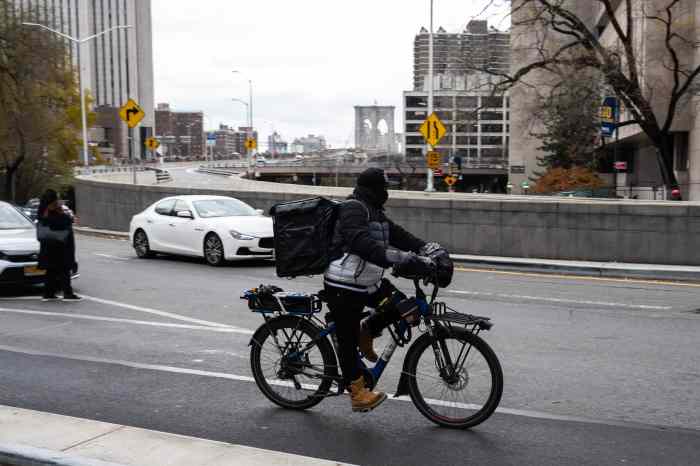Seventy years ago Friday, 4,413 allied forces were killed in the D-Day invasion, 2,499 of them Americans. Thousands more were injured, and thousands more would die before “Operation Overlord” concluded on June 30, 1944.
The invasion of Normandy was the first combat mission for Rocco Moretto, then 19 years old, seasick and terrified. Being dropped from a landing craft ramp into the blood-reddened waters of Omaha Beach as German shells rained down “was a horror,” Moretto recalled Tuesday at a Manhattan VA Hospital ceremony where he was honored by Rep. Carolyn Maloney.
Laden with more than 60 pounds of ammo and equipment, Moretto fought not to drown in the rough, roiling surf. “As soon as I hit the beach, there were 12 guys laying there, dead and dying,” said the Astoria resident, now 89. “One guy was trying to talk to me,” but no words escaped his mouth. Moretto just kept going: “Our mission was to take the beach.”
As depicted in the movie “Saving Private Ryan,” the sands of northern France were soaked in a tide of blood shed by the 160,000 allied troops who arrived that day to save the world from Adolf Hitler.
The “greatest generation” that fought in WWII is dwindling in number. Of the 16 million Americans who served, slightly more than one million remain alive, with about 54,153 remaining in New York State. About 555 of them die each day nationwide, and by 2036, it’s believed that none will be alive, according to The National WWII Museum.
Local WWII vets recall the invasion as occurring in a world that differed so utterly from today as to be inconceivable. Communication was ponderously slow. Without digital distractions, every serviceman was so completely absorbed in his own task, so utterly focused on obeying his training, doing his duty and accomplishing his mission, he had neither time nor opportunity to keep tabs on the chess game being played on the world map. The invasion was the most massive amphibious attack ever executed — a brilliant tactical strike that became a legendary masterpiece in military history. But the atomic bombs dropped on Hiroshima and Nagasaki 14 months later proved to be the glue that ultimately sealed the fate of the Axis powers.
Julius Freeman, 87, a member of the Tuskegee Airmen, watched the Normandy invasion in a newsreel accompanying a 10-cent movie in Lancaster, Kentucky, as a 17-year-old. “That’s one of the reasons I went into the Air Force: I saw what happened when you went into the infantry!” recalled Freeman, who now lives in Springfield Gardens.
“Those fellows came out of those boats in 10 feet of water and then came up on the beach while the Germans were shooting them down like anything,” recalled Freeman, who enlisted in the Air Force four months later, becoming a medical technician and eventually defusing bombs in Germany.
Pat Dolan, 92, of Morris Park in the Bronx, was fighting in Italy during D-Day. “We took Rome,” two days before, but Normandy was more prominently covered in the press, infuriating Gen. Mark Clark, Dolan said. “He felt slighted,” as did other soldiers who felt the folks at home “forgot all about Italy,” where casualties were also profound, recalled Dolan, a U.S. Army private who earned four medals and went on to become a TWU labor organizer.
Italy “was a very, very rough campaign and we lost a lot of men,” Dolan recalled of the effort that claimed 60,000 Allied lives in less than 20 months. Troops there had little awareness of what was transpiring on the beaches of France, in part because the military newspaper, Stars and Stripes, was their only source of news, Dolan said. “We just figured the war wasn’t over yet: We had to keep on working and take all those towns,” Dolan recalled.
Joe Garofalo, 93, a Seabee in the Fourth Marine Division of the U.S. Navy, who also lives in Morris Park, was in the middle of the Pacific, preparing for a gory invasion of his own: That of Saipan, a week later. “We had a lot of casualties — over 2,000 on just one small beach on June 15,” Garofalo recalled. Garofalo’s unit landed in conditions similar to Normandy, unloading supplies in a beach with no cover while under relentless artillery shelling by the Japanese. “That went on for two full days, day and night,” he said. At night, “any guy who stood up to relieve himself was killed by his own men,” — comrades were under instructions to shoot anyone not taking cover in a fox hole. “It was just horrible,” Garofalo recalled. After Saipan, Garofalo went to Tinian, where he and others built the air strips for the Bockscar and Enola Gay — the B-29s that dropped the atomic bombs, named Fat Man and Little Boy, on Japan.
Morty Matz, 89, owner of an eponymous public relations firm, was training to become a navigator for B-29s — the planes that dropped the atomic bombs — in Gulfport, Mississippi. “It was wonderful to have D-Day, but I was training for a war that was still going on. I was preparing to go to the Pacific,” and there was no time to analyze or reflect, said the Upper East Sider. “Obviously, you were rooting for the home team, but as a practical matter, you just didn’t have time: You got up in the morning and trained.”





































